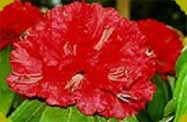|
Curcuma longa
Roxb.

|
Species |
Curcuma longa
Roxb. |
|
Local Name |
Hardi (Nep),Manya (Lep) |
|
Synonym |
|
|
Family |
Zingiberaceae. |
|
Habitat |
A tall perennial
herb. Cultivated in humid climatic regions of the plains
of India. |
|
Distribution |
Distributed in tropical and temperate region. |
|
Sikkim |
Cultivated throughout Sikkim except in the alpine
region. |
|
Out side |
West Bengal, Bihar, Andhra Pradesh, Tamil Nadu,
Maharashtra, China, Bhutan (Phuntsoling district). |
|
General |
Himalaya (Garhwal- Bhutan), Assam, Myanmar.
|
|
Morphological |
A perennial herb. Rootstock
large, ovoid with sessile, cylindric tubers orange-
coloured inside. Leaves very large in tufts up to 1.2 m
or more longer, including the petiole which is about as
long as the blade, oblong- lanceolate, tapering to the
base. Flowers in autumnal spikes, 10- 15 cm, long,
peduncle 15 cm or more, concealed by the sheathing
petiole, green flowering bracts, covering yellow
flowers. |
|
Flowering |
July-August. |
|
Fruiting |
September -November |
|
History |
Curcuma is said to be "from the Persian Kurkum", a name
applied also to saffron |
|
Parts |
Rhizome. |
|
Status |
Cultivated,
endangered in wild. |
|
Phytochemistry |
The essential
oil obtained by steam distillation of dry rhizomes has
been reported to contain α- phellandrene, d- sabinene,
cineole, borneol, zingiberene and sesquiterpene ketones.
In the recent analysis of the essential oil, tuemerone
ar- turmerine and sabonone have been identified in the
ketonic fraction besides p- cymene, isocaryophyllene,
trans β-farnesene, δ- curcumene, β- bisabolene and β-sesquiphellandrene.
Recent work on the study of sesquiterpenes has revealed
a new compound curlone.
The crystalline colouring matter curcurnin is deferuloyl
methane. |
|
Agrocultivation |
|
|
Reference |
1. Anonymous
(1992). The Useful Plants of India. Publication and
information Directorate, CSIR, New Delhi, 152.
2. Bentley,
Robert and Henry Trimen (1992). Medicinal Plants.
Prashant Gahlot for Allied Book Centre, Dehradun, 269.
3. Handa, S.S.
and Kaul, M.K. (1996). Supplement of Cultivation and
Utilization of Medicinal Plants. Regional Research
laboratory, CSIR, Jammu Tawi, 36.
4. Kirtikar, K.R;
B.D. Basu (1994). Indian Medicinal Plants (Vol. IV).
Bishen Singh Mahendra Pal Singh, Dehradun, 2423- 2425.
5. Progress
Report of the Project "Studies on Medicinal Plants of
Sikkim" (1998- 2001). State Council of Science and
Technology for Sikkim.
6. Thakur, R.S.,
H.S. Puri, Akhtar Hussain (1989). Major Medicinal Plants
of India. Central Institute of Medicinal and Aromatic
Plants Lucknow, 234- 235. |
|
Medicinal |
|
|
Ayurvedic |
The plant is laxative, anthelmintic, vulnerary, tonic,
alexiteric, emollient; improves the complexion; useful
in "Kapha" and "Vata", diseases of the blood, leucoderma,
scabies, urinary discharges, inflammations, ozoena, bad
taste in the mouth, biliousness, dyspepsia,
elephantiasis, snake bite, small pox, swellings, boils,
bruises, sprains. |
|
Unani |
In unani system,
roasted turmeric is an ingredient of "Hab Narkachur",
used as antidysentric for children. Powdered turmeric is
used in tooth powder and (Marham) paste. It is used in
liver problem, jaundice, urinary discharges, scabies and
bruises. It is a well- known domestic remedy for
dressing wounds, bites and in the form of paste as an
anti- inflammatory and antiseptic agent for smearing on
the swollen parts and skin. The decoction of turmeric is
used in conjunctivitis for relieving the pain. In coryza,
the fumes of burning turmeric directed into the nostrils
cause a copius mucous discharge and relieve the
congestion. |
|
Traditional |
The paste prepared with the combination of mustard oil
is applied on itching due to bacteria infection on the
body parts. |
|
Others |
|
|
Prepartation |
|
|
Picture |
|
|
|
|
|

Rhododendron


Amongst the many
floral treaties of Sikkim Himalaya one of the earliest ones may be
found over the genus Rhododendron (Gk. rhodo = red, dendrons = tree
). |
| |
|
|
|

Orchid


Orchid
known for their brilliance in colors, unusual shapes
attractive growth habits, variety in fragrance and
exquisite beauty can attract any nature lovers.
|
| |
|
|
|

Medicinal Plant


Sikkim
with its total geographical area of 7,096 sq km is
bestowed with a huge diversity of flora and fauna.
|
| |
|
|
|
|
|